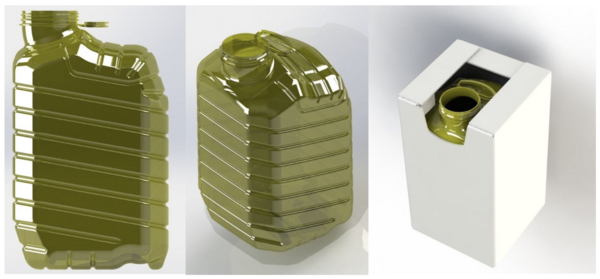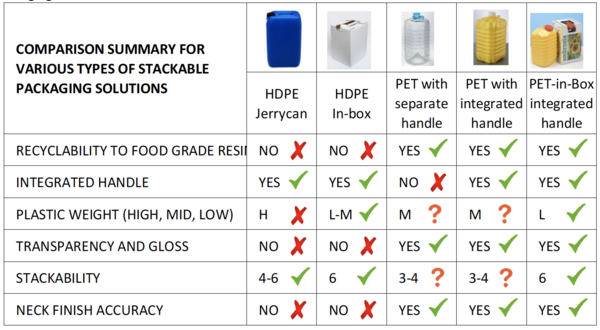There is a trend for HDPE jerry cans to be replaced by PET stackable bottles due to the substantially lower weight. With careful design, the weight of a PET stackable bottle could 40% less than the equivalent size HDPE jerry can. Additionally, PET exhibits high mechanical strength, transparency, a smooth and glossy surface finish and can be 100% recycled back to food-grade PET. Importantly, the neck of a PET container is injection moulded, with very accurate dimensions, enabling leak-proof closure without the need of costly wads.
The main drawback of PET has been the inability to have an integrated handle, like for HDPE jerry cans. This had been resolved by inserting a separately moulded handle in the neck of the PET bottle, which involves making or buying the handle and assembling it onto the neck of the bottle. This extra cost for the handle reduces the overall cost saving that arises from the lower weight of PET stackable bottles.
TECHNOLOGY
PET stackable bottles can be produced using either single-stage or two-stage PET technology, with single-stage being the most suitable method considering:
1. The usual advantages of single stage vs two-stage technology:
- Substantially lower energy consumption.
- Lower blowing pressure.
- No packing materials for preforms.
- No storage space or transport for preforms.
- Less labour requirements.
2. The quantities of stackable bottles required are usually within the capabilities of single-stage technology.
3. Limited preforms supply for two-stage bottle blowing for this application.
4. Ability to optimize bottle weight, offered by the single-stage process, rather than having to use the weight of preforms available in the market.
CYPET Technologies Ltd offers its patented single-stage PET processing technology, which enables the production of large PET stackable bottles with integrated rigid handle up to 50 liters. No other single or two stage machine can produce larger than 25-liter PET stackable bottles.
In 2015 CYPET had successfully executed its first project for replacing HDPE jerry-cans with PET stackable bottles for edible oil application. The bottle design was developed by CYPET engineers to reduce weight for maximum strength, saving up to 50% raw material cost compared with HDPE jerry cans. Since the
successful completion of this first project, CYPET has received orders for 4 additional systems to produce PET stackable bottles of 9, 16, 17, 18, 20 and 25 litre sizes.
CYPET’s unique single-stage technology offers two significant advantages compared to other single-stage machines:
1. For easy and comfortable handling of stackable bottles, CYPET machines can produce bottles with an innovative strong integrated handle, which eliminates the need for additional and costly production steps of producing a handle separately and then fitting it on the bottles. Additionally, the handle being of the same material as the bottle, makes the bottle easily recyclable.









